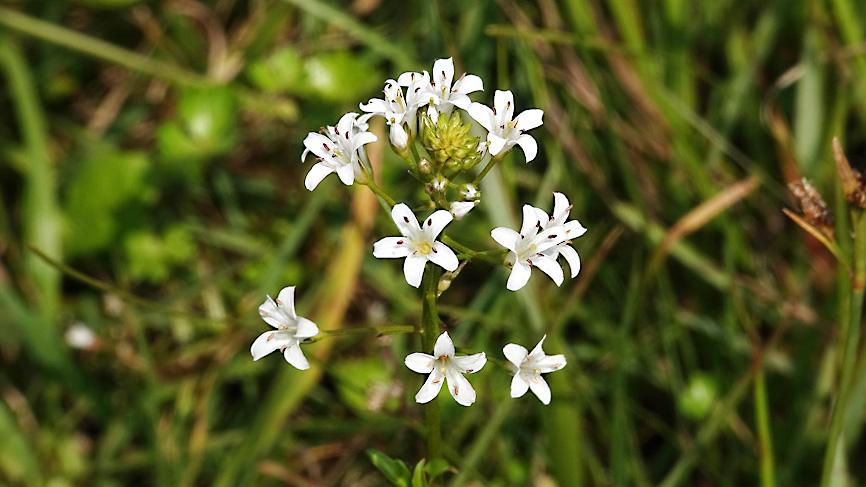The Keelung City Government and the Wild Bird Society of Keelung are aiming to restore the Lysimachia candida, a species thought to be extinct since the early 1900s, at an ecological pool near Keelung’s Nuannuan District (暖暖).
The last time the plant was officially recorded was in 1897 by Japanese naturalist Seikihiro Yano.
Considered extinct by the Red List of Vascular Plants of Taiwan report, the plant was last month discovered by a plant enthusiast surnamed Su (蘇).

Photo provided by the Wild Bird Society of Keelung
Su said that she found the plant growing on a grassy slope, and sent a photograph to other enthusiasts because she had never seen it before.
Chung Shih-wen (鐘詩文), an expert at the Taiwan Forestry Research Institute, and Yang Tsung-yu (楊宗愈), a researcher at the National Museum of Natural Science, visited the ecological pool and identified the plant as Lysimachia candida.
The plant has flourished, with three to four clusters within a range of 100m, the experts said, adding that they surmised the clusters have been growing for about three to five years.
Society director Shen Chin-feng (沈錦豐) on Friday said that the city government should be credited for the rediscovery of the plant, as it had used lawn mowers and not herbicides to maintain the grass near the ecological pool.
The plant is facing the sun and is not covered by trees, meaning that given time, its survival is almost guaranteed, Shen said.
The society would be keeping the plant’s location a secret for now, Shen said, urging others who know about the discovery to also keep quiet to increase the chances that the plant will survive.
Shen also called on plant enthusiasts not to remove the plant from its habitat and to allow it to flourish and grow.
The plant usually develops fruit between March and July, the city government said, adding that it had agreed to collaborate with the society.
The society would be tasked with collecting the seeds of the plant while the city government would nurture the plants, it said.

SHIPS, TRAINS AND AUTOMOBILES: The ministry has announced changes to varied transportation industries taking effect soon, with a number of effects for passengers Beginning next month, the post office is canceling signature upon delivery and written inquiry services for international registered small packets in accordance with the new policy of the Universal Postal Union, the Ministry of Transportation and Communications said yesterday. The new policy does not apply to packets that are to be delivered to China, the ministry said. Senders of international registered small packets would receive a NT$10 rebate on postage if the packets are sent from Jan. 1 to March 31, it added. The ministry said that three other policies are also scheduled to take effect next month. International cruise ship operators

NUMBERS IMBALANCE: More than 4 million Taiwanese have visited China this year, while only about half a million Chinese have visited here Beijing has yet to respond to Taiwan’s requests for negotiation over matters related to the recovery of cross-strait tourism, the Tourism Administration said yesterday. Taiwan’s tourism authority issued the statement after Chinese-language daily the China Times reported yesterday that the government’s policy of banning group tours to China does not stop Taiwanese from visiting the country. As of October, more than 4.2 million had traveled to China this year, exceeding last year. Beijing estimated the number of Taiwanese tourists in China could reach 4.5 million this year. By contrast, only 500,000 Chinese tourists are expected in Taiwan, the report said. The report

HORROR STORIES: One victim recounted not realizing they had been stabbed and seeing people bleeding, while another recalled breaking down in tears after fleeing A man on Friday died after he tried to fight the knife-wielding suspect who went on a stabbing spree near two of Taipei’s busiest metro stations, Taipei Mayor Chiang Wan-an (蔣萬安) said. The 57-year-old man, identified by his family name, Yu (余), encountered the suspect at Exit M7 of Taipei Main Station and immediately tried to stop him, but was fatally wounded and later died, Chiang said, calling the incident “heartbreaking.” Yu’s family would receive at least NT$5 million (US$158,584) in compensation through the Taipei Rapid Transit Corp’s (TRTC) insurance coverage, he said after convening an emergency security response meeting yesterday morning. National

The Forestry and Nature Conservation Agency yesterday launched a gift box to market honey “certified by a Formosan black bear” in appreciation of a beekeeper’s amicable interaction with a honey-thieving bear. Beekeeper Chih Ming-chen (池明鎮) in January inspected his bee farm in Hualien County’s Jhuosi Township (卓溪) and found that more than 20 beehives had been destroyed and many hives were eaten, with bear droppings and paw prints near the destroyed hives, the agency said. Chih returned to the farm to move the remaining beehives away that evening when he encountered a Formosan black bear only 20m away, the agency said. The bear